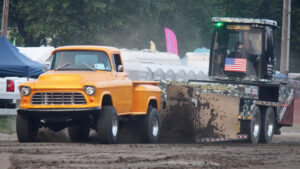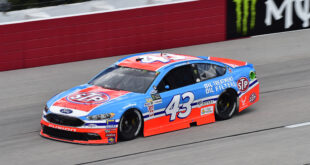The common theme in motorsports is horsepower, and it’s ever changing how it is utilized. It’s not about who has the most power, but who can use the power at the right time. This is why NASCAR events that come down to fuel mileage are intriguing since the horsepower then is not as important, but rather when the power is used. Indy Car can go into a fuel-saving setup on the fly during the race.
At the same time, one sport’s focus is solely on power. It takes those same elements of when the power needs to be utilized, but in a much different aspect.
Across the country, at fairgrounds, speedways, and even added during off-weekends at drag strips, the countless truck and tractor pulls that happen bring together crowds that absolutely thrill all ages by the sheer noise and engineering that goes into some of these vehicles.
Multiple different classes allow the appeal to a vast array of people. Those that love trucks get a variety of ideas in setups, from modified four-wheel drive machines that can be powered by gasoline, diesel, or even an alcohol-powered engine to some wheelstanding action of two-wheel drive machines that have superchargers attached. Some run the same kind of tires found on the highways and dirt paths, some use tires that are found in circle track racing, and some classes use exclusively-manufactured tires made for pulling.
 Trucks are not always the class that gets attention, at least not initially. Once the big rig machines hook to the sled, things are different.
Trucks are not always the class that gets attention, at least not initially. Once the big rig machines hook to the sled, things are different.
For a long time, the only way a big rig truck would be able to hook to the sled was to have distance between the rear tires and the front of the weight-transfer machine, a good 15 feet in some cases. The reason: hooking up to the common hitch would be ineffective, as the semi would tow it around the track just like a flatbed trailer. Having the weight so far back helped pull the semis to a halt on the track.
Now, pulling promoters have gotten smarter, moving the hitch point on the semis from between the rear tires, to below the rear axles. Those heavy machines are no match for advancement and physics, and the fans enjoy every moment.
If trucks aren’t the cup of tea for fans, the vast classes of tractors certainly can find a fit for everyone.
Supercharged motors, turbo chargers, multiple turbo chargers, light or heavyweight, the tractor classes have so many options and concepts that everyone can find something they can relate to and enjoy. Fans get into battles over the tractor makers that it becomes a war on the pulling track, although a friendly one. Fans of John Deere go to war against those enjoying the International Harvesters, while a few take hold of the Ford tractors.
Some feed off alcohol, some blow smoke, but the tractor classes are what started this industry. Farmers were trying to see who had the best and strongest tractor in the county, pulling weight and seeing how far they can go.
When that wasn’t enough, they began improving the tractor, more power, more torque, and in the long run, that became the catalyst to the mini rods and the modifieds.
The mini rod tractors for many years could be considered the wildest ride in tractor pulling. Putting an engine that puts out 2000 horsepower in a specially-built chassis that weighs 2000 pounds makes for an entertaining hook. Things can, and do, go awry quickly. But, when these mini machines hook up and have a solid outing, the fans go wild.
However, nothing can compare to the absolute power, noise, and frenzy of the unlimited modified tractors.
When the concept of more power came into play in tractor pulling, it truly is a case of “There’s no replacement for displacement.” Back in the 70’s, it was not uncommon to suddenly see tractors beginning to have a pair of engines on one chassis, but as the years went by, more and more got added. Some were in line, some hooked to the sides, and by the late 1980s, four classes of tractors were ultimately put to use, with the only difference being the weight of the vehicle. Anywhere from 5800 pounds all the way up to the unlimited classes, the modified tractors were the class people wanted to see, and did so at the expense of ear drums.
 It was not uncommon to see tractors in that era running four engines, some ran five, even six, and one somehow managed to put seven on one chassis.
It was not uncommon to see tractors in that era running four engines, some ran five, even six, and one somehow managed to put seven on one chassis.
These tractors have advanced to the point where the times of having six engines is not needed, but the type of power has not changed. Some run V8s, while others decide to go the way of using aircraft technology, bolting on turbines or Allison engines made for helicopters or planes.
Tractors have become safer over the years, with the addition of mandatory roll cages, kill switches, and driver controls. Time and technology have constantly made these machines, and the sport, safer and better for everyone involved.
Each year there’s always some in the stands that don’t understand the concept of truck and tractor pulling, or how it operates.
The easiest comparison is to drag racing. These vehicles are not going over 300 MPH down a 1000-foot track, looking for ET and speed. On a track that is a marked distance of 300 feet, but with a buffer, there is no true finish line. Pulling a piece of equipment that is the equivalent of 15 tons before adding weight in the box, the object is not to make it to the end of the track as fast as possible, but to try and make it to the end of the track, if possible.
The sled constantly getting heavier as the pulling vehicle makes it’s way down the track, moving from a rolling weight on the back to a dragging weight, eventually having all the weight put right on the back of the vehicle to try and slow it down.
Years earlier, seeing many tractors go past the 300-foot distance, making a “Full Pull” meant the teams had to make a turnaround and prepare to do so again in a Pull-Off. The sled would get reset with more weight, and a faster speed, trying to stop the driver from making it down the full distance.
Now, with the cost of maintaining the vehicles, from engines to components, and travel expenses, the idea of a pull-off is no longer utilized. Officials measure as far as they need to in order to determine the winner, and that can sometimes be within thousandths of an inch.
Is truck and tractor pulling for every motorsport fan? Maybe not, since the downtime from unhooking one competitor to getting the sled set and the next puller coming up is not for everyone. Some may say the noise is too much in some of the classes. That may be the case, but if anyone has felt and heard the power of a nitro funny car or dragster, the noise comparison is there but in a different way. A nitro methane engine is loud, but because of the speed those cars run you only hear it for a very short time.
Truck and tractor pulling, especially the high-horsepower classes like the modified 4×4’s, super-modified two-wheel drives, and the modified tractors, will be noisy. But, it’s a prolonged noise simply because going fast down the track is not exactly something pulling is known for. However, it is a true calling card for this industry, and would not be a true tractor pull without some noise on the track.
It’s an acquired taste, but unless one experiences it for the first time, there’s no way to know if it is a sport to enjoy. So, go find a pull near you, and feel the power.
 All About Horse Power Motorsports 24/7
All About Horse Power Motorsports 24/7



